This was published 5 years ago
Travel in Guatemala: The one rare thing worth seeing in Central America's most diverse country
By John Huxley
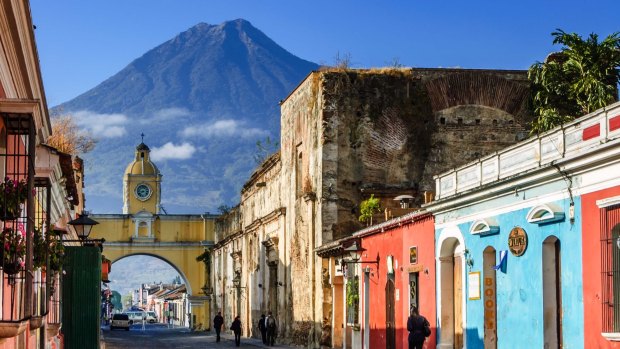
Agua volcano behind Santa Catalina Arch, Antigua. Credit: Shutterstock
It's six o'clock in the morning. After a 4.30am wake-up call, a rushed 5am breakfast, a rapid boat-ride across the 600 metre-deep Lake Atitlan and a rickety truck ride out into the highlands of Guatemala, we have reached our destination. Well, up to a point. A starting point.
For the next 3½ hours, my wife and I and our local guides, Maynor and Aaron, climb the steep, slippery mist-clad slopes of the Paquisis Volcano.
In places, the "path" seems invisible, impossible. Here it's wet and slippery with overnight rain, there it is crumbling down, over almost vertical banks. Even with neat walking-sticks hacked from the tumble of trees, the going is difficult, going on dangerous.
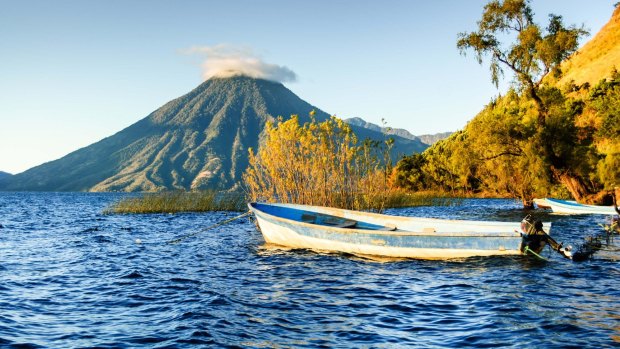
San Pedro Volcano, seen across Lake Atitlan in the Guatemalan highlands.Credit: Shutterstock
"Just don't look down," Maynor suggests, cheerfully. It seems sound advice … at least to the point where we reach our target, turn around and, with knocking knees, climb/crawl back down the volcano.
So what on earth – especially this dizzying, crumbling earth – are we doing, hiking up volcanoes in the spectacular wilds of a Central American country visited so far by few Australians?
We have flown 27 hours from Sydney to Guatemala City, via San Francisco and Houston – and will take 61 hours to fly back; another story – to this little green dot on a map to see just one thing: a bird, a big, very rare, slightly comical bird called a horned guan. It's a big, black-and-white number, 86 centimetres tall, immediately identifiable by its bright red wattle and topknot.
Roadside vendors offer refreshments such as melons, dried bananas and live iguanas.
The bird is uncommon, secretive, static and, after more than three hours hiking including one hour of looking, seemingly invisible. Ho hum. Such disappointments must be expected. And anyway there are many more remarkable things to see and do in a country whose history has been dotted and blood-stained with disaster.
In 1976, an earthquake killed 22,000 people. Between 1960 and 1996 alone the country fought a civil war in which an estimated 200,000 Guatemalans died. The country still has serious political problems, but somehow its 17 million inhabitants manage to soldier on, cheerfully.
Most visitors to Guatemala, the vast majority of them American, head straight for the spectacular Mayan ruins of Tikal, an ancient, abandoned city of towering temples, pyramids, plazas and wide walkways, set in jungle and dating back to before the birth of Christ. Indeed, the first, highly-advanced Mayan cities – based on writing, art, architecture, mathematics and astronomy – date back to about 750BC. To this day, more than 40 per cent of Guatemalan people are indigenous, the majority of them Mayan.
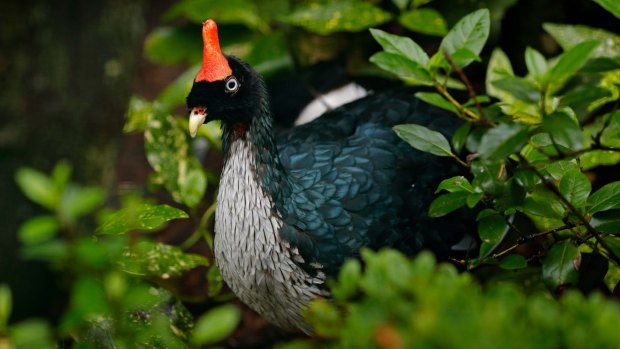
The slightly comical and very elusive horned guan.
Such is the scale and vibrant inventiveness of Mayan civilisation that two or three days could be comfortably devoted to exploring the breathtaking ruins of Tikal. One day we will return. For now, though, we cram in as much sightseeing, exploring and, yes, birding, as possible, starting – after a 45-minute drive from Guatemala City airport – with a couple of days exploring the former capital of Antigua.
As Lonely Planet says, the city is "a place of rare beauty … a real miracle … a global hotspot". Literally. Its inhabitants have survived earthquakes, volcanic eruptions, floods and other natural disasters, one of which caused the city to be abandoned in the late 18th century. With its unchanged, narrow cobbled streets, criss-cross grid-system lay-out, imposing Spanish colonial architecture, beautiful old courtyard-style hotels, churches, convents and colourful markets, all set against a rumbling, volcanic backdrop, the city oozes charm.
It's a dizzying, dazzling introduction to a trip that will take us up, up through the highlands of Guatemala, up mountains, beneath towering volcanoes, through jungles and roadside villages, poor places filled with smiling, colourful people.
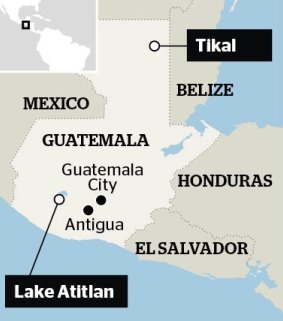
Guatemala map.
Apart from downtown Guatemala City and a short stretch of the Pan American Highway, the quality of the roads ranges from barely acceptable to atrocious. Two bodies, presumed dead, lie by the side of the "main road" to our overnight stop-over, the spectacular Las Cumbres eco-lodge.
On the long drive back to the capital, there is a traffic jam of dozens of vehicles in each direction, halted for a few hours by "road works". Roadside vendors offer refreshments such as melons, dried bananas and live iguanas to philosophical locals. Many roads in Guatemala don't work, except in short stretches. Just as we get going we hit the so-called "rush hour" traffic in the capital.
Our colourful Guatemala adventure includes rumbling volcanoes, museums, and friendly locals; the memorials, markets and restaurants of Antigua and a visit to the Santiago de Atitlan church, which ingeniously incorporates both Catholic and Mayan influences. We stay at the lakeside Posada de Santiago hotel, owned by imaginative, eco-friendly Americans, who supply free canoes, kayaks, paddleboats, bikes, a guide brochure full of clever ideas and cheeky comments, as well as impromptu country/pop concerts.
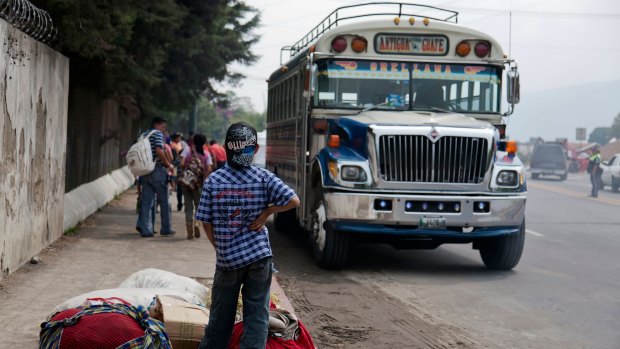
A traditional bus in Antigua, Guatemala.Credit: Alamy
And, of course, there are the birds, more than 800 species, in all shapes and sizes, all colours, including the famous resplendent quetzal, Guatemala's national bird, and today's target, the elusive horned guan.
Slowly, we make our way down the volcano, trying not to look very far down, trying not to think about the elusive bird. It seems we have "dipped out" on the bird as we reach an altitude below which the guan has only very, very rarely been seen.
Then, there is a shout from way above from our guides. "Up here, up here. Quick as you can." With renewed vigour we scramble and scamper back up the mountain. "There, over there," says Maynor, dragging us into line above his tripod. Sure enough, after more than four hours searching, there it is, sitting immobile on a far-off branch, silhouetted against the bright, blue sky – the rare horned guan. And if that was not enough, the following day we see the quetzal. A fine finish to a fabulous holiday.
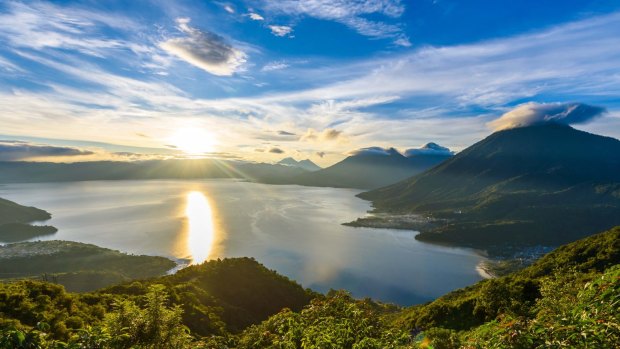
Sunrise over Lake Atitlan, Guatemala.Credit: Shutterstock
TRIP NOTES
John Huxley travelled at his own expense.
FLY
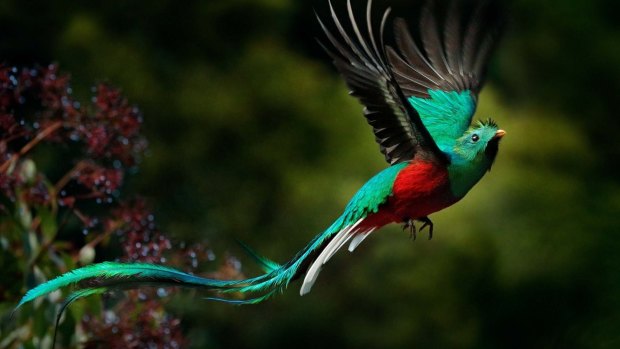
The resplendent quetzal.Credit: Shutterstock
Guatemala is a long trip from Australia, inevitably through the United States. We travelled from Sydney to Guatemala via San Francisco and Houston on United Airlines. See united.com
TOUR
Our local, English-speaking tour guides were provided by Birding Expeditions whose experts were knowledgeable about everything from Mayan civilisation to civil wars and volcanoes. The tour cost $2080 a person for nine days, including all accommodation, meals and guides. Accommodation ranged from top-notch chain hotels, such as the Raddison in the capital, to beautiful old masterpieces in Antigua to eco-lodges. Most accommodation in Guatemala is cheap by Australian standards.
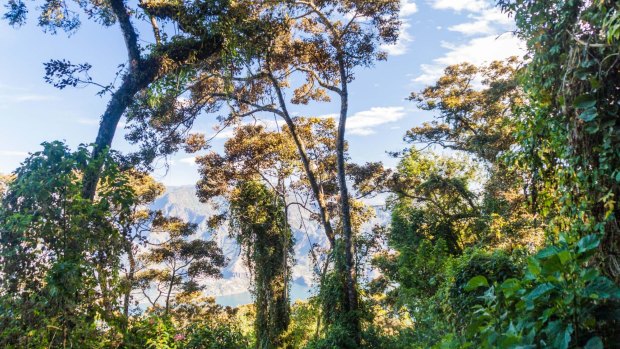
Cloud forest on San Pedro volcano.Credit: Shutterstock
MORE
Sign up for the Traveller Deals newsletter
Get exclusive travel deals delivered straight to your inbox. Sign up now.